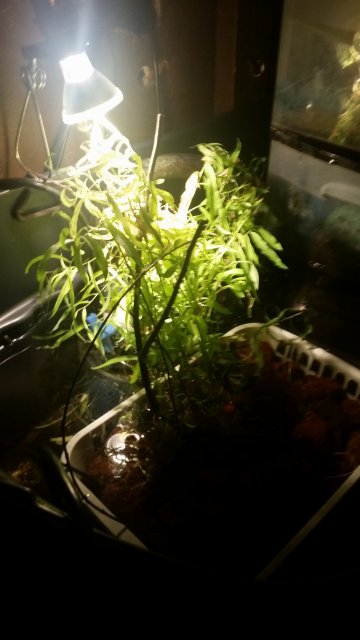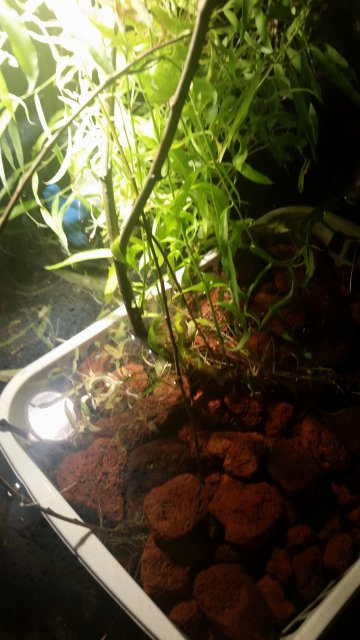I have been keeping turtles for 20 years off and on and been into fishkeeping just as long. I have been an avid lurker on this site as well as turtle forums for years. just absorbing information from fellow hobbyists.
I have kept a Matamata for the past 5 years now it has grown from a little 4 incher to 10 inches in that time. I originally kept mine in a very shallow depth as most of the literature I read suggested. However now she is kept in a depth of 30 inches with sloping logs and wood for her to pick her preferred depth. She hangs out at the bottom on the sand bed. I gradually increased the water depth to allow her time to strengthen her leg muscles and become accustomed to the depth. Contrary to popular belief they are not sedentary turtles by any means. Mine is constantly exploring her environment and uses the whole aquarium she is currently housed in (220g). These turtles are capable of floating at the water's surface (mine would frequently float under the floating plants and ambush fish from there) if they need to, they can and will actively pursue prey, as well as lie in wait and ambush fish as they swim by. Mine has shown all these traits.
There is a book you can purchase on amazon that I found to be a good read that covers in detail everything from husbandry, common diseases, sexing, breeding, incubating and hatching eggs. It is a small paperback book but I have found it more useful than most information I have found on the internet. The book is titled Matamatas: The Natural History, Captive Care and Breeding of Chelus Fimbriatus by David Fogel.
My opinion, your original sand bed was deep enough 2" (I would worry about dead spots in sand that deep and an accumulation of anaerobic bacteria), mine never fully buried herself, she would dig a pit in the sand but not burry herself. The leaves are the real key, they provide the camouflage they need. Be prepared to clean your filters often as the leaves begin to break down. Keep the flow low but do provide some. I often find her playing in the little currents I have created to blow debris out of the dead spots in my aquarium. I try to keep the water towards the surface as calm as possible though so she can breath and float without having to work too hard.
I keep the pH as low as I can, around 5-6 I have found too much higher than 6.5 and she begins sloughing off large amounts of skin. I keep the water temperature between 78-82 degrees, and she does have a spot to haul out if she so chooses, but never has in the time I have had her (she does rest pretty high up when sleeping at night). I do massive water changes every two weeks, 70% not because I need to but just because the Nitrites and Ammonia levels are always at 0 I don't care too much about my nitrates because turtles aren't as affected by them. When I do check them randomly they usually are around 10ppm. I still have not gotten her to accept frozen thawed food. She will suck them in but immediately spit them back out, I have tried several recommended methods including long fasts ( longest was 4 weeks). So now I am breeding tilapia to feed her and a few other fast breeding/growing fish (lower risk of parasites, I control what they eat and I can gut load with whatever I want before she eats them. Guppies, mollies, platys and swordtails are all too small (normally suggested). I also use bait fish (minnows) after quarantining and treating. She can and will eat fish over the 3" mark. I have marbled crayfish, waiting for the colony to grow before I offer them as well. Not sure if she will eat them or not.
As far as tank mates, I currently house her with a breeding pair of Discus and a pleco. The care requirements are similar with the discus so I have not had a problem with either, they are too big to eat, wont compete for food, and don't pick at the flanges on the turtle. obviously the turtle isn't messing with them either because they are way too big to eat. I am thinking about removing the pleco because every now and then I see it trying to suck at the slime coat of the discus. Not trying to breed discus so don't care about the eggs. I have a small school of silver dollars I am growing out, but right now they are food size so they are in my 125g.
If you are not already I highly suggest you start breeding fish for feeding, as every thing you read says, feeder goldfish and rosy red minnows are bad, and buying the live bearers at the quantity these guys eat is just not feasible, mine would easily go through 100 in 4 days. The cheapest places I could buy them you are still looking at $1 per fish. So start a breeder culture of convicts or tilapia or something if you have not yet.
This is just my care method and what I have experienced over the past 5 years. I am not an expert by any means and I ma constantly learning but this is what I do for mine. I am currently looking for a male the same size or slightly larger in hopes to try my luck at breeding in the future.




